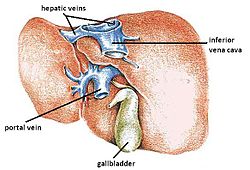Hepatic veins
| Hepatic vein | |
|---|---|
 Posterior abdominal wall, after removal of the peritoneum, showing kidneys, suprarenal capsules, and great vessels. (Hepatic veins labeled at center top.) | |
 The hepatic vein is one of two veins of the liver, as shown in this diagram. | |
| Details | |
| Precursor | vitelline veins |
| Drains to | inferior vena cava |
| Artery | Hepatic artery |
| Identifiers | |
| Latin | venae hepaticae |
| MeSH | D006503 |
| TA98 | A12.3.09.005 |
| TA2 | 4994 |
| FMA | 14337 |
| Anatomical terminology | |
In human anatomy, the hepatic veins are the blood vessels that drain de-oxygenated blood from the liver into the inferior vena cava. They are one of two veins connected to the liver, the other set being the portal veins.
The large hepatic veins arise from smaller veins found within the liver, and ultimately from numerous central veins of the liver lobule. None of the hepatic veins have valves.
Structure
The hepatic veins can be divided into an upper and a lower group.
- The upper group typically arises from the back of the liver, are three in number, and drain the quadrate lobe and left lobe.[citation needed]
- The lower group arise from the right lobe and caudate lobe, are variable in number, and are typically smaller than those in the upper group.[citation needed]
Clinical significance
Budd–Chiari syndrome is a condition caused by blockage of the hepatic veins. It presents with a "classical triad" of abdominal pain, ascites, and liver enlargement. The formation of a blood clot within the hepatic veins can lead to Budd–Chiari syndrome. It occurs in 1 out of a million individuals. The syndrome can be fulminant, acute, chronic, or asymptomatic.
The hepatic veins may be connected with the portal veins in a TIPS procedure.
Additional images
-
Human embryo with heart and anterior body-wall removed to show the sinus venosus and its tributaries.
-
Longitudinal section of a hepatic vein.
-
Hepatic vein
External links
- Hepatic veins - definition - medterms.com
- Hepatic veins - Ultrasound - University of the Health Sciences in Bethesda, Maryland



